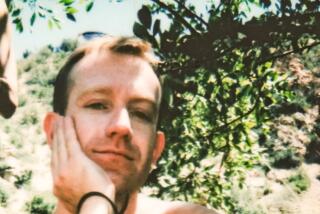PAT NIXON THE UNTOLD STORY by Julie Nixon Eisenhower (Simon & Schuster: $19.95; 445 pp.)
PAT NIXON’S PORTRAIT in the White House says more about her First-Ladyhood than she intended. It exudes immense sadness, and although she loathes the image of the tragic queen, the portrait confirms everything the public felt about Richard Nixon’s wife.
In her biography of her mother, Julie Nixon Eisenhower also created a portrait of Pat Nixon. Her intention is to show other dimensions--humor, warmth, courage in the face of terrible adversity, the admiration her mother won abroad in 20 years of extensive world travel as vice president’s wife and First Lady. But however many anecdotes, however many explanations about her mother’s character and the dynamics of her marriage, Eisenhower’s book confirms Pat Nixon’s public image and becomes a companion piece to Henriette Wyeth Hurd’s sad portrait.
The humor is swamped by the pain. The warmth is hidden by the reserve. And however many Pat Nixon fans there are out there (and there are many, judging by the 1.25 million pieces of mail she received after her 1976 stroke) most Americans have a lasting impression of Pat Nixon as a woman whom public life knocked the stuffing out of, who bowed out with her head held high and her tears bitten back stoically. By any lights, a tragic figure.
First Ladies, like Presidents, usually get stuck with the first thumbnail sketches that the White House press corps draws of them. These caricatures, though crude and simplistic, usually turn out to be true. Books like Eisenhower’s can explain and elaborate, but in the end, the first quick images are the lingering ones.
Jacqueline Kennedy Onassis will always carry the glamour label. Ladybird Johnson will be the lady who planted the daffodils, whatever else she did. Betty Ford will be remembered for her support of ERA and her frank admission about being hooked on tranquilizers and alcohol. Rosalynn Carter’s lasting image will be her Southernness and her intense dedication to mental health. Nancy Reagan will be remembered for her love of luxury as well as her efforts to combat drug addiction. Pat Nixon for her stiff upper lip in the face of fierce anti-Nixonism.
Loyalty to a husband, love of family, enjoyment of children, dignity in high office, all these are givens. When they’re stripped away, what’s left is that one description that is a First Lady’s individual, personalized label. And necessarily, like any label, it is brief and unqualified.
Eisenhower’s book is neither brief nor unqualified. She has a whole life to tell, which she does persuasively. And given Pat Nixon’s abiding sense of privacy, she’s the only one who could have done it. She tries to remain detached, and this objectivity is maintained for about half of the book. Inevitably, it is lost in the latter half when the focus is on Vietnam and Watergate. The cool note serves her well in the first half, as she keeps “Pat Nixon” at arm’s length, and the partisan tone of the second half serves her equally well as she passionately portrays the inside story of a besieged presidency.
Pat Nixon’s early life, from her 1912 birth in copper boom town Ely, Nev., is a classic tale of rural hardship. After moving to Artesia in Southern California, her Irish father Will Ryan--formerly a sailor, miner and prospector--taught himself farming from books on crop raising, learning to raise “the best cabbages for miles.” Thelma, as Pat was baptized, was well loved by her father, her German mother Kate and her two brothers. But money was tight; life was a struggle, and the Ryan children learned to be stoical in hiding their feelings. As a hangover from her hatred of angry scenes between her parents, Pat Nixon always “detested” scenes. Julie quotes her as saying how, to avoid them, she “accommodated to others.” When Kate Ryan died, Pat was 13. For the next years, she not only ran the farm household but achieved top grades at school. After Will Ryan’s death, she added a job and college, and changed her name to Patricia, because she’d never liked the name Thelma. Through these hard times, Pat found pleasure and escape in school and college plays. With her red gold hair and her beauty, her daughter writes, she was offered a chance to act in a movie, which she turned down. While she worked her way through the University of Southern California, one of Pat’s part-time jobs was as a movie extra, another modeling high fashion clothes to customers at Bullock’s.
The movie opportunities were rejected because “that life is too tough--one of the reasons why girls are tempted to accept presents and attentions--sheer necessity,” Pat wrote to a friend at the time. Julie quotes one of Pat’s professors about the young Pat Nixon: “She was a quiet girl and pretty. And it always used to disturb me how tired her face was in repose. There seemed to have been plenty of reason for it. As I recall it, if you went into the cafeteria there was Pat serving. If you went into the library there was Pat checking out books. If you went back to the campus that evening there was Pat working on some student research program. Yet with it all, she was a good student, alert and interested. She stood out from the empty-headed overdressed sorority girls of the era like a good piece of literature on a shelf of cheap paperbacks.”
In 1937, she began her teaching career at Whittier Union High School, just eight miles from her old home in Artesia. The Quaker town of Whittier had a deputy city attorney named Richard Nixon.
The pattern of their courtship fits with the girl who turned down Hollywood for teaching. Pat was loathe to commit herself to this determined suitor she’d met when both acted in the same local play, who told her the night they met, “You may not believe this, but I am going to marry you some day.” Later, when they were dating, Pat told her friends: “He’s going to be President some day.”
Pat revealed to him little about her tough childhood. “Both were shy and both would find it difficult in the years ahead to break through their reserve and discuss their deepest feelings,” Julie explains, adding resonance to the long-held Washington view that Pat Nixon’s taut reserve was an unnecessary extra burden she laid on herself.
The courtship extended over two years, until finally Richard Nixon’s surprisingly romantic love letters and their happy hours together on a lonely stretch of nearby beach called San Clemente ended her resistance. They were married in June, 1940. Two years later, Richard Nixon became the general counsel of the new Office of Price Administration in Washington, D.C. Following World War II, when Nixon served in the Navy, came their first campaign. And with Nixon’s election to Congress, Pat stepped into the world of Washington politics, punctuated by bouts of campaigning, which led to the Senate, the vice presidency and the presidency.
As First Lady, Pat Nixon’s modesty made her reluctant to choose a “project” for herself. By the time Betty Ford succeeded her, it had become clear that some sort of identifiable public effort in behalf of some crying public need was to be the First-Lady format of the future. Pat Nixon’s focus on “volunteerism,” even then, seemed too diffuse to become a public-relations plus.
Despite her extensive travels abroad, which won her admiration for kindness and warmth, despite her additional decoration of the White House with antiques, despite many domestic miles promoting volunteer projects, Pat Nixon’s public persona never quite came alive. Perhaps it was the mask she wore to cover her pain as Vietnam made the name Nixon hated on American college campuses. Perhaps it covered the distress of seeing her loving support of Nixon misread, as she was portrayed as a victim of his ego.
Julie quotes Henry Kissinger’s observation after the Vietnam settlement: “What a gallant lady she has been. With pain and stoicism she had suffered the calumny and hatred that seemed to follow her husband. Unlike the President, she was not capable of the fantasy life in which romantic imaginings embellished the often self-inflicted daily disappointments. She was totally without illusions and totally insistent on facing her trails in solitude. Her dignity never wavered. And if she seemed remote, who could know what fires had to be banked in her stern existence. She made no claims on anyone; her fortitude had been awesome and not a little inspiring because one sensed it had been wrested from an essential gentleness.” And that was before Watergate!
Julie Nixon Eisenhower’s book is written with love for both her parents. With the same spirit that took her among hostile audiences defending her father over Watergate--(and you can read her defense in this book)--she tries to counter the image of Pat’s sadness with instances of humor and cheerfulness. But she also quotes her mother’s hairdresser saying that while she never saw Pat Nixon in a bad mood, “sometimes I think she should have shouted and screamed.” Many would agree with that. Perhaps some shouts and screams would have proven therapeutic, instead of the repression of emotion that led, in 1976 while reading Woodward and Bernstein’s “The Final Days” to a stroke that left her partially paralyzed. With yet another battle to face, against her own body.
Today, despite a second stroke and a bout of illnesses, Pat Nixon is pictured by her daughter as a woman who is calm and content with her loving husband and her garden in Saddle River, N.J.
She was as reluctant to have Julie write this book as she was to have her White House portrait painted, that portrait which, she says, “makes me look too sad.” So does her daughter’s book, but it is a work which in the end inspires some understanding and awed admiration for Pat Nixon’s fortitude. In unfolding what she calls “The Untold Story,” Eisenhower presents Pat Nixon through the eyes of those who loved her instead of the eyes of those who labeled and pigeonholed her.
In essence though, there isn’t a lot of difference between the two pictures, the one so detailed and descriptive, the other so stark. If she was Plastic Pat, it was because the mask, she thought, could never be taken off. It was a cruel, self-imposed iron mask, and it’s good to know that First Ladies since haven’t felt the same compulsion to cover their feelings. Dignity and pride have to be maintained in the national spotlight, but not necessarily in the White House private quarters. First Ladies can afford, today, to show some of their true feelings. They are allowed to be human. This was Pat Nixon’s tragedy, her confusion of dignity with repression. But few First Ladies have had so much prolonged stress to bear. Julie Nixon Eisenhower’s book fulfills its aims. It is a book about courage in the face of overwhelming odds.
More to Read
Sign up for our Book Club newsletter
Get the latest news, events and more from the Los Angeles Times Book Club, and help us get L.A. reading and talking.
You may occasionally receive promotional content from the Los Angeles Times.







